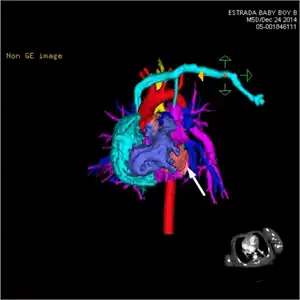Asplenia with cardiovascular anomalies
| Asplenia with cardiovascular anomalies | |
|---|---|
| Other names: Ivemark syndrome | |
 | |
| This condition is inherited in an autosomal recessive manner | |
Asplenia with cardiovascular anomalies, also known as Ivemark syndrome and right atrial isomerism,[1] is an example of a heterotaxy syndrome. These uncommon congenital disorders are characterized by defects in the heart, spleen and paired organs such as the lungs and kidneys. Another name is "asplenia-cardiovascular defect-heterotaxy".[2]
Right atrial isomerism is named for its discoverer, Swedish pathologist Biörn Ivemark.[3]
Signs and symptoms
In right atrial isomerism, both atria of the heart are morphological right atria leading to associated abnormalities in the pulmonary venous system. In addition, individuals with right atrial isomerism develop asplenia, a midline liver, malrotation of the small intestine and the presence of two morphologic right lungs. Individuals with left atrial isomerism, by comparison, have two morphologic left atria, polysplenia, intestinal malrotation and two morphologic left lungs.[4]
The majority of cases present at the time of birth or within a few days or weeks. Presenting signs and symptoms of the congenital heart defect may include cyanosis, breathlessness, lethargy and poor feeding.
Causes
The cause of heterotaxy is unknown.[5]
The Ivemark Syndrome Association, which is based in Dorset,[1] is one of the organisations dedicated to helping sufferers and funding research.
Diagnosis

The diagnosis of this condition, Asplenia with cardiovascular anomalies, can be done prenatally by fetal ultrasound[6]
After birth the following are used for diagnosis:[6]
- Blood test
- Medical history
- Echocardiogram
Treatment
Treatment for this condition can be done via the following:[6]
- Symptom specific
- Surgery (cardiac)
- Prophylactic antibiotics
References
- 1 2 "Ivemark Syndrome Association". Patient UK. 2008-11-10. Archived from the original on 30 May 2009. Retrieved 2009-05-27.
- ↑ Konstantinidou, A.; Sifakis, S.; Koukoura, O.; Mantas, N.; Agrogiannis, G.; Patsouris, E. (Aug 2008). "Pancreatic aplasia in a fetus with asplenia-cardiovascular defect-heterotaxy (Ivemark syndrome)". Birth Defects Research Part A: Clinical and Molecular Teratology. 82 (8): 601–4. doi:10.1002/bdra.20467. PMID 18496831.
- ↑ IVEMARK, BI. (November 1955). "Implications of agenesis of the spleen on the pathogenesis of conotruncus anomalies in childhood; an analysis of the heart malformations in the splenic agenesis syndrome, with fourteen new cases". Acta Paediatrica Supplement. 44 (Suppl 104): 7–110. doi:10.1111/j.1651-2227.1955.tb05346.x. PMID 13292296. S2CID 221418617.
- ↑ "Ivemark Syndrome". National Organization for Rare Diseases. Archived from the original on 28 May 2009. Retrieved 2009-05-24.
- ↑ "'Jigsaw Kid' lives with jumbled up internal organs". The Telegraph. 2009-05-22. Archived from the original on 25 May 2009. Retrieved 2009-05-24.
- 1 2 3 "Ivemark Syndrome". NORD (National Organization for Rare Disorders). Archived from the original on 15 August 2020. Retrieved 22 October 2021.
External links
| Classification | |
|---|---|
| External resources |
|